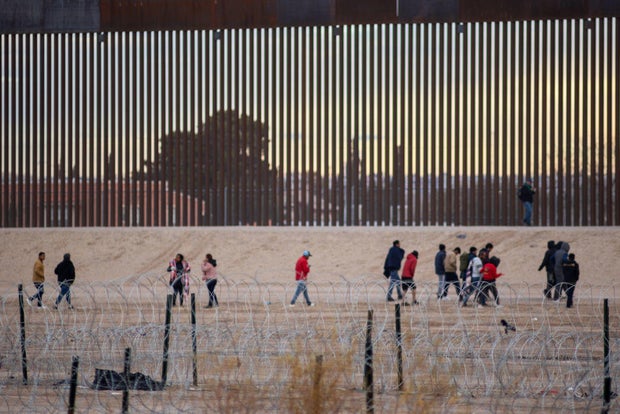Washington — There’s currently an intense debate about what legal authorities President Biden has at his disposal to deal with the humanitarian crisis at the U.S. southern border, where migrant apprehensions have reached record levels in recent years.
The debate escalated recently after Mr. Biden promised to “shut down” the U.S.-Mexico border if Congress passes an immigration compromise that his administration has been negotiating with a small bipartisan group of senators. While the agreement has not been officially released, sources directly familiar with the talks have told CBS News that it would give the executive branch the power to partially shut down asylum processing when illegal border crossings reach certain levels.
Mr. Biden’s pledge to “shut down the border” was likely shorthand for clamping down on illegal crossings and asylum claims, since completely shutting down an international boundary would bring legal travel and trade to a halt — an unprecedented move that would hurt both the U.S. and Mexican economies.
Here are the facts about what Mr. Biden can do now legally at the border and what he can’t do, at least without congressional intervention:
What authority does Biden currently have?
David Peinado/Anadolu via Getty Images
Mr. Biden has the legal authority to reinstate the border policies implemented by former President Donald Trump that he ended, since they were based on proclamations, regulations and international agreements.
Those now-defunct Trump policies include agreements that allowed the U.S. to reroute asylum-seekers to third countries and the “Remain in Mexico” program, which required migrants to await their asylum hearings outside of the U.S. Federal law allows officials to return asylum-seekers to Mexico, but it does not require it, as decreed by the Supreme Court in 2022.
U.S. law also gives the president, through the attorney general and the secretary of homeland security, the power to place limits on asylum. And Mr. Biden already has.
After the Title 42 pandemic-related border restrictions ended last spring, the Biden administration enacted a regulation that presumes migrants are ineligible for asylum if they enter the U.S. without using any of the legal immigration pathways it created, or have passed through a third country without seeking asylum. But the administration has not been able to implement these asylum restrictions at scale because it does not have the necessary asylum officers, detention facilities and money.
The president, however, does not currently have the legal authority to unilaterally suspend U.S. asylum law, which grants migrants on American soil the right to request humanitarian refuge, even when they cross into the country illegally.
Only Congress can change U.S. asylum law.
Did Trump try to “shut down” asylum claims at the border?
Yes, and his efforts were struck down in federal court.
Trump tried to single-handedly suspend asylum in between ports of entry along the southern border through a proclamation in 2018, using a law House Speaker Mike Johnson and other Republicans have urged Mr. Biden to invoke.
While the Supreme Court allowed the Trump administration to use this law — known as Section 212(f) — to enact restrictions and bans on legal immigration and travel, such as the infamous “travel bans,” federal courts prevented the government from citing this authority to suspend asylum law. Trump’s 2018 rule was ultimately declared unlawful.
What authorities would the emerging deal in Congress give Biden?
The emerging deal in the Senate would effectively give Mr. Biden — and his successors, for that matter — the power Trump sought to invoke in that 2018 proclamation.
It would allow or require the Department of Homeland Security to partially suspend asylum law in between official ports of entry when there’s a spike in illegal crossings. Sources familiar with the deal said the power would be mandated after average daily migrant crossings hit 5,000 over seven days, or 8,500 in a single day. It could also be activated on a discretionary basis after average daily crossings surpass 4,000 in a week.
When the authority is invoked, migrants who cross into the U.S. illegally would not be allowed to ask for asylum, and would face swift deportation to Mexico or their home country. Access to the U.S. asylum system would be preserved at official border crossings.

